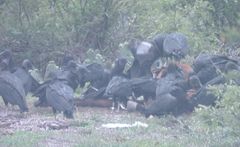| New World vultures | ||||||||||
|---|---|---|---|---|---|---|---|---|---|---|

American Black Vultures on a cow carcass
|
||||||||||
| Scientific classification | ||||||||||
|
||||||||||
|
Cathartes Coragyps Gymnogyps Sarcorhamphus Vultur |
The New World vultures family Cathartidae contains seven species found in warm and temperate areas of the Americas. It includes five vultures and two condors. Except Cathartes, all genera are monotypic.
The five species of vulture are:
- Turkey Vulture Cathartes aura
Greater Yellow-headed Vulture Cathartes melambrotus
Lesser Yellow-headed Vulture Cathartes burrovianus
King Vulture Sarcorhamphus papa
American Black Vulture Coragyps atratus
The Condors are
- California Condor Gymnogyps californianus
- Andean Condor Vultur gryphus
Evolution and systematics
New World vultures are most probably not closely related to Old World vultures or other diurnal raptors, which themselves are often classified in different orders. They rather resemble Old World vultures because of convergent evolution and are usually considered to be more closely related to storks, as is reflected by their placement in the Ciconiiformes and supported by karyotype (Ligon, 1967), morphological, mtDNA cytochrome b sequence (Avise et al., 1994; Wink, 1995) and behavioral data. Nonetheless, this has been criticized more recently, as the Ciconiiformes - not only in Sibley & Ahlquist's undoubtedly paraphyletic, but also in the traditional sense - appear not to be a monophyletic assemblage. Consequently, there is a recent trend to raise the New World vultures to the rank of an independent order Cathartiformes not closely associated with either birds of prey or storks or herons (Ericson et al, 2006).
A related extinct family were the Teratornithidae or Teratorns, essentially an exclusively (North) American counterpart to the New World vultures - the latter were, in prehistoric times, also present in Europe and possibly even evolved there. The Incredible Teratorn is sometimes called "Giant Condor" because it must have looked similar to the modern bird. They were, however, not very closely related but rather an example of parallel evolution, and the external similarity is less emphasized in recent times due to new information suggesting that the teratorns were more predatory than vultures (Campbell & Tonni, 1983).
The fossil history of the Cathartidae is fairly extensive, but nonetheless confusing. Many taxa that may or may not have been New World vultures were considered to be early representatives of the family. There is no unequivocal European record fom the Neogene and trying to retrace the evolutionary history of the entire Ciconiiformes sensu Sibley & Ahlquist by means of molecular analysis has proven to be just as equivocal until the mid-2000s.
At any rate, the Cathartidae had a much higher diversity in the Plio-/Pleistocene, rivalling the current diversity of Old World vultures and their relatives in shapes, sizes, and ecological niches. Extinct genera are:
- Diatropornis (Late Eocene/Early Oligocene -? Middle Oligocene of France)
- Phasmagyps (Early Oligocene of WC North America)
- Brasilogyps (Late Oligocene - Early Miocene of Brazil)
- Hadrogyps (Middle Miocene of SW North America)
- Pliogyps (Late Miocene - Late Pliocene of S North America)
- Perugyps (Pisco Late Miocene/Early Pliocene of SC Peru)
- Dryornis (Early - Middle Pliocene of Argentina; may belong to modern genus Vultur)
- Aizenogyps (Late Pliocene of SE North America)
- Breagyps (Late Pleistocene of SW North America)
- Geronogyps (Late Pleistocene of Peru)
- Wingegyps (Late Pleistocene of Brazil)
- Parasarcoramphus
Fossils found in Mongolia (Late Oligocene), Lee Creek Mine, USA (Late Miocene/Early Pliocene) and Argentina (Middle Pliocene) have not been assigned to a genus yet. There is also a number of extinct congeners of the extant species; see the respective genus accounts.
An European genus from the Earliest Neogene that possibly belongs to the New World vultures is Plesiocathartes. On the other hand, the bathornithid Neocathartes was long believed to be a peculiar New World vulture (including charming, but inaccurate reconstructions as a kind of Turkey Vulture on stilts).
References
- Avise, J. C.; Nelson, W. S. & Sibley, C. G. (1994) DNA sequence support for a close phylogenetic relationship between some storks and New World vultures. Proc. Natl. Acad. Sci. USA 91(11): 5173-5177. DOI:10.1073/pnas.91.11.5173 PDF fulltext. Erratum, PNAS 92(7); 3076 (1995). DOI:10.1073/pnas.92.7.3076b (PDF fulltext)
- Campbell, Kenneth E. Jr. & Tonni, E. P. (1983): Size and locomotion in teratorns. Auk 100(2): 390-403 PDF fulltext
- Ericson, Per G. P.; Anderson, Cajsa L.; Britton, Tom; Elżanowski, Andrzej; Johansson, Ulf S.; Kallersjö, Mari; Ohlson, Jan I.; Parsons, Thomas J.; Zuccon, Dario & Mayr, Gerald (2006): Diversification of Neoaves: integration of molecular sequence data and fossils. Biology Letters, in press. DOI:10.1098/rsbl.2006.0523 PDF preprint Electronic Supplementary Material
- Ligon, J. D. (1967): Relationships of the cathartid vultures. Occasional Papers of the Museum of Zoology, University of Michigan 651: 1-26.
- Wink, M. (1995): Phylogeny of Old and New World vultures (Aves: Accipitridae and Cathartidae) inferred from nucleotide sequences of the mitochondrial cytochrome b gene. Zeitschrift für Naturforschung 50(11-12): 868-882.
External links
- New World vulture videos on the Internet Bird Collection




 216.73.216.91
216.73.216.91 User Stats:
User Stats:
 Today: 0
Today: 0 Yesterday: 0
Yesterday: 0 This Month: 0
This Month: 0 This Year: 0
This Year: 0 Total Users: 117
Total Users: 117 New Members:
New Members:
 216.73.xxx.xx
216.73.xxx.xx
 Server Time:
Server Time: